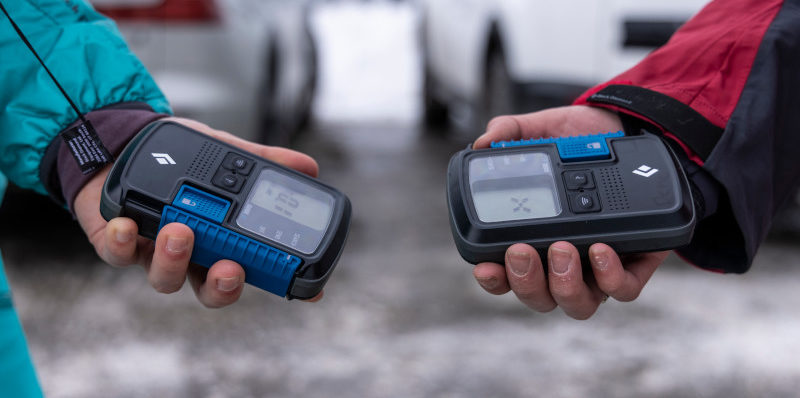P: Adam Clark / Black Diamond
The avalanche transceiver, as the technical heart, is an integral part of the standard safety gear. Every member of the group must have this standard equipment, otherwise a quick companion rescue is impossible and the survival chances of the buried person decrease drastically. Especially beginners and less ambitious freeriders are often faced with the choice of agony: Which is the right equipment for me? Do I have to buy it new or is a second-hand device enough? In this article we explain the 5 core functions of a modern avalanche transceiver and provide you with a practical guide, should you want to buy a device used.
5 core functions of modern avalanche beacons
3 antennas
According to the current state of the art, all devices work in digital mode with 3 antennas. These allow better processing of the searched avalanche signal. Consequently, beacons with three antennas are not only easier to use but also faster in the search. In transmit mode, there is no difference between devices with 2 or 3 antennas; here, only the longest antenna transmits along the X-axis of the device.
Self-test
Every modern avalanche transceiver performs a self-test when it is switched on. This checks the functionality and warns of possible problems. Depending on the manufacturer, the self-test can also be performed via the smartphone app.
Group check
In the group check, the device ignores all signals above a certain distance and only confirms signals in the immediate vicinity. This function is helpful to check the correct transmission function of all avalanche beacons in groups of several people.
Marker function
The marking function is one of the most important functions of modern avalanche beacons and supports the searcher considerably in the case of multiple burials. If the first located buried victim is very deep, this signal can be marked. The searching avalanche transceiver ignores this signal from then on and enables the searcher to search for further signals in the sense of a triage.
Back-Up Mode
The back-up mode is a safety function that switches the searcher’s transceiver back to transmit mode if it has not been moved for a certain period of time. This ensures that rescuers who have been buried by a post-avalanche can be located. This function can be turned off or the time set depending on the device.
BONUS: Beginners vs. top devices
In addition to the top devices, every manufacturer also offers entry-level models. These often have fewer functions, but their handling and user guidance are optimized so that they are particularly suitable for freeriders. The top devices, on the other hand, have all functions, even those that are only very rarely needed. Only those who intensively engage with the device and the corresponding search methods can use the full potential of these devices.

Buying an avalanche transceiver used?
Since freeriding and ski touring are booming as a trend sport, avalanche beacons hardly experience a price drop and remain at a price level of 100-150€ from a certain age. However, many devices are already outdated and do not have the functions listed above. In order to use the device longer and in the best possible way, the 5 functions should be available. In addition, there are also a few other things to consider:
- Recall: Was the device affected by a recall or even taken off the market by the manufacturer? If so, hands off!
- Maintenance & Software: The transceiver should have the latest software version. Ideally, the device was sent to the manufacturer for maintenance before sale to guarantee the functionality. If this is not the case, you are buying a pig in a poke.
- Condition: Stay away from devices that have external damage such as cracks in the housing or damaged displays!
Battery compartment: The battery compartment should be clean. Mold-like stains or discolouration indicate leaking batteries – in this case again: hands off! - Scope of delivery: The device should be complete, e.g. including carrying strap. Alternatively, the device must be carried in a bag specially designed for this purpose.
Written By:
Nicolas Metz
CEO Delayon Eyewear & avalanche commissioner
Nico has always been drawn to the mountains and after years of experience in the sports industry, his geography studies in Innsbruck laid the foundation for a scientific understanding of snow. On this basis, he founded Delayon Eyewear in 2016. In 2018, the Hamburg native completed the avalanche commission's training by the State of Tyrol. Nico experienced the record winter of 2018/2019 with the Innsbruck Avalanche Commission on his local mountain, the Nordkette. Snow safety is a special concern for the passionate snowboarder. He passes on his knowledge and experience to students as a course instructor at the University of Innsbruck. His commitment became known through Instagram and various media appearances.










